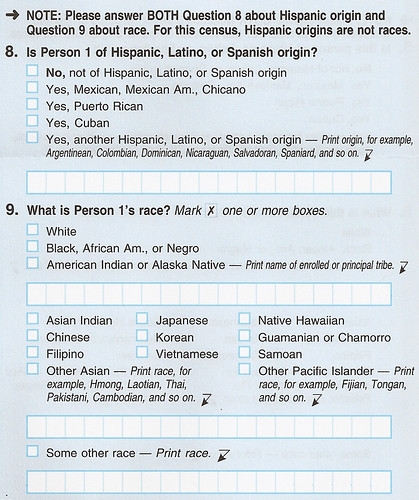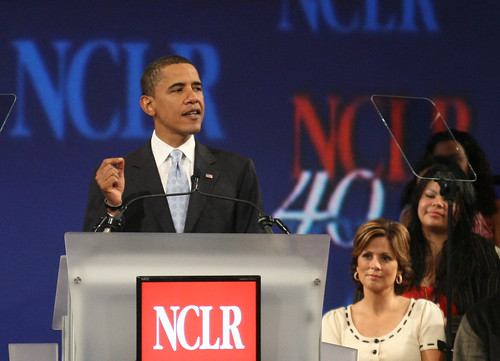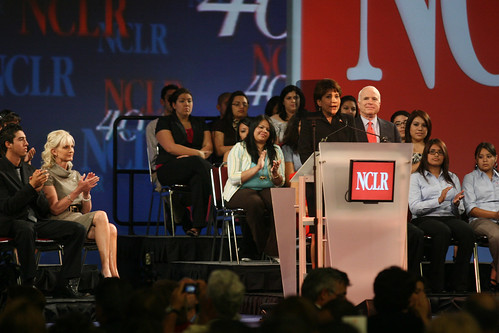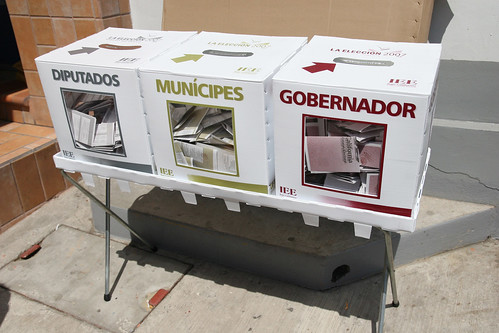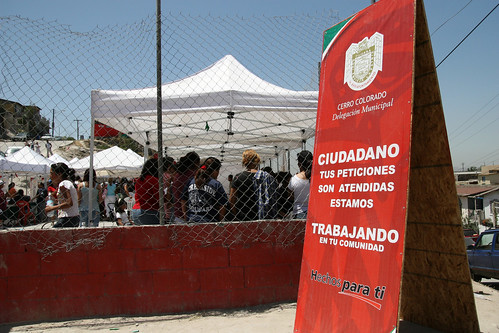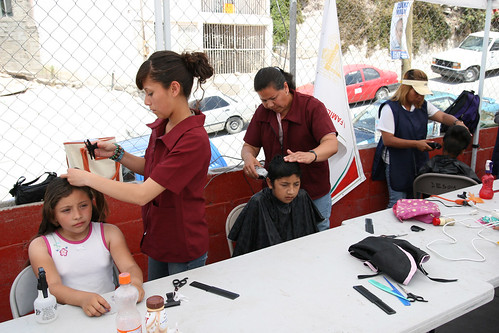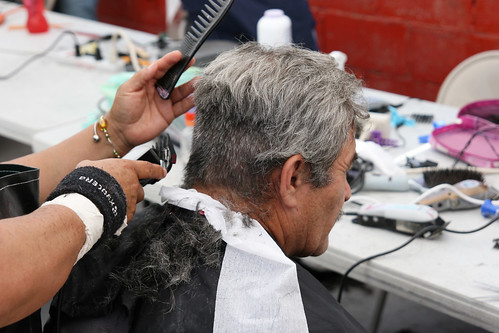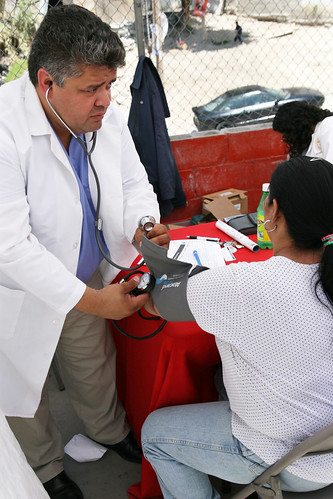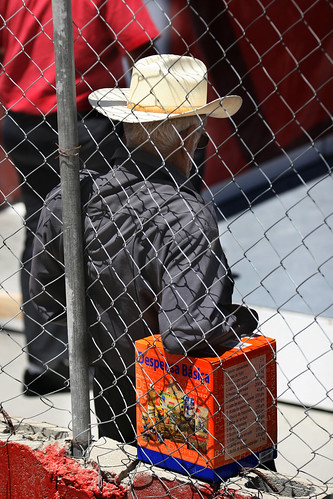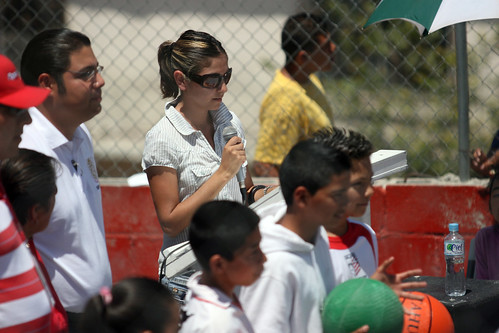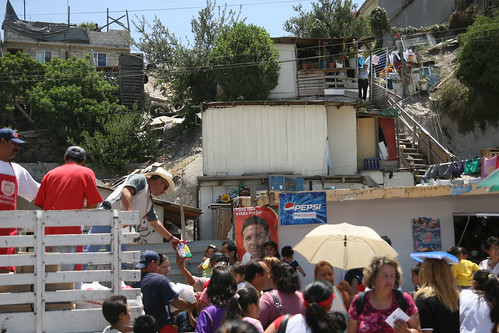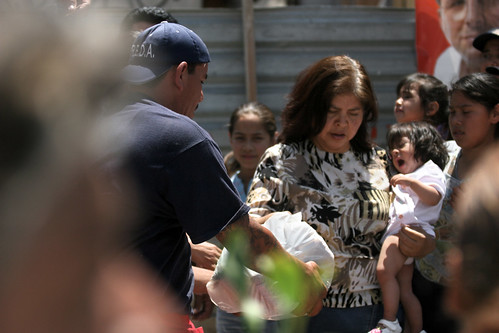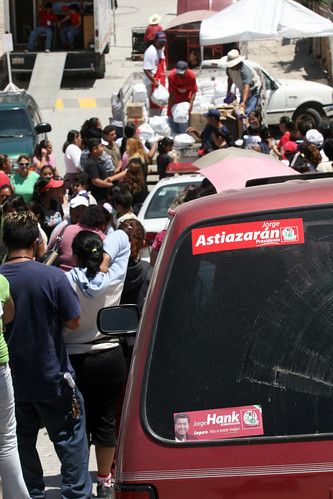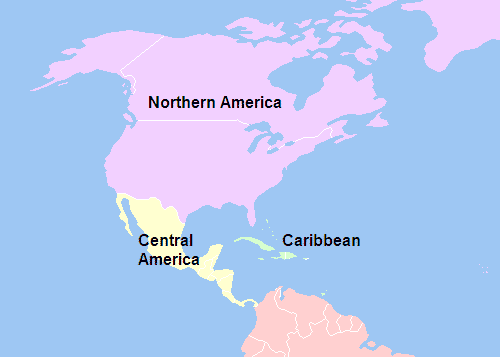Category: politics
I’ve taken my camera with me to vote for the last several elections resulting in both good and bad experiences. When San Diego used touch-screen machines for the first time, I was able to get a shot using my digital SLR. On another election day, I was stopped and aggressively questioned by a poll worker for trying to take a cellphone photo.
Here’s the problem. The legality of cameras inside polling places isn’t black and white; the laws vary state by state. Plus, some poll workers have only received basic training and will apply their own judgement. The Citizen Media Law Project suggests four things to avoid getting yourself into trouble: follow the rules, be discreet, don’t interfere with voters or the process, respect the buffer zone.
In California, election codes aren’t particularly clear. They prohibit recording within 100 feet of anyone entering or exiting the polling place with the intent to dissuade others from voting. This is where the above guidelines come in; stay low-key and they’ll likely leave you alone. I spoke with the San Diego County Registrar of Voters and they said photography and video will be allowed up to 25 feet away.
While inside the polling area, California Elections Code says you must be in the process of voting (i.e. not using a camera), are limited to 10 minutes, and can’t show your vote to others (i.e. not documenting your vote). While it doesn’t specifically state “no cameras allowed,” legal precedent hasn’t cleared up the specifics. Government officials err on the side of caution. The California Secretary of State’s office says it has “historically taken the position that use of cameras or video equipment at polling places is prohibited, though there may be circumstances where election officials could permit such use.” When I spoke to the San Diego County Registrar of Voters, they said they won’t allow cameras inside the polling place except for credentialed journalists.
From a certain angle, this all seems very oppressive. This is a free country and I should have the right to video my vote, right? Yes, but other voters should also have the right not to be surveilled while voting. Poll workers are commissioned to protect the vote and can kick you out, even calling the police if you cause enough of a disturbance. This can all be avoided by sticking to the suggestions mentioned above. Pay attention and be careful not to record other people unwillingly.
Publish Your Photos and Videos on Election Day
- YouTube and PBS have partnered with Video Your Vote to gather first-hand accounts on election day. They’ve arranged the videos on a map to note voter intimidation and other problems at the polls.
- The New York Times’ Polling Place Photo Project collects images to create “an archive of photographs that captures the richness and complexity of voting in America.”
- Video The Vote is a watchdog group organizing people to document voter suppression and other problems.
(Attn. Homeland Security: In photography, “shooting” is a term we use for “photographing” someone. You know, as in “photo shoot.” So no need to worry. And by “worry”, I mean wiretap, surveil, or put me on a list. I’m not a terrorist.)
In July, I was fortunate enough to get the photo assignment to shoot presumptive presidential nominees John McCain and Barack Obama. They visited San Diego for the National Council of La Raza conference.
Barack Obama at the National Center of La Raza Conference
Obama delivered a speech punctuated by applause. But it was still a bit lukewarm compared to what I expected. I’d heard stories of his charismatic delivery and rockstar-like receptions. That was all there, I guess, but there was a lingering stress in the air. Obama needed to get defeated Hillary Clinton supporters excited about voting for him. He got loud cheers in reference to oppressive immigration raids, but applause was absent from his discussion of details: securing the border first, path to citizenship starts at the back of the line, fines for non-legal status, etc. When the speech was over, he shook hands with the students seated behind him and made his way slowly through the front edge of the crowd.
The press were given a sideline area at about half-court in the convention center’s large ballroom. My 70-200mm zoom lens only got me close enough for a decent medium-wide shot. I had to crop the shot above by 50 percent to get something usable. At this distance, my lens looked pretty weak compared to the pros bumping shoulders next to me — the ones you see at sports games with what look like space-age sniper rifles. I was disappointed that I wasn’t able to get closer and, more specifically, that we weren’t allowed to get any closer. The only concession was being taken two-by-two into the center aisle for about 60 seconds, once.
John McCain at the National Council of La Raza Conference
McCain’s appearance had a dramatically different tone. For starters, his wife Cindy McCain accompanied him on stage. It felt warmer than Obama’s solo performance, somehow less formal and more classy at the same time. I couldn’t help thinking McCain scored a few extra “family values” points with the Latino crowd. He spoke not as if he were trying to impress, but as if he were having a conversation with friends. He took questions from the audience after his speech. And after conference organizers said the Q&A session was over, McCain threw the microphone into the crowd to take another question.
Before the speech began, there were rumors that we’d be escorted in small groups to the front lines. Apparently the McCain people caught wind of photographer’s complaints and agreed to allow us better access than during Obama’s speech. The conference staff members I spoke with said the campaign staff set the rules in terms of press access, not the conference itself.
Conclusions
McCain’s performance was definitely the most interesting of the two candidates, not only in terms of his interaction with the crowd but in his campaign’s interaction with the press. But I’m not sure how much of a difference it makes in the end. Of the photos I uploaded to Flickr, Obama’s mediocre shots have been viewed more than twice as much as McCain’s more dynamic photos. And of McCain’s, two-thirds of his views come from the photos of his wife Cindy.
We don’t learn anything terribly valuable from these numbers. Yeah, Obama has more buzz than McCain. And on average, Cindy McCain has more than either of them. Perhaps it’s really only an indicator of the superficial nature of the statistical mob. We can only hope the people vote based on their version of who will be the best president, not merely on who will be a best looking one.
We pulled into the parking space and hopped out. I slung the camera from my neck, twisting the branded strap so the words “Canon EOS Digital” didn’t show.
I’m fascinated by Mexican elections. It’s so simple and straightforward. Just paper ballots and a black crayon.
 |
I watched the 2006 presidential election count in my mother-in-law’s neighborhood. She was serving as a poll worker. Representatives from each party were present, collectively counting and sorting each ballot. The public oversight, caution and security I saw that day inspired much more faith in the final count than the electronic voting machine I would use months later.
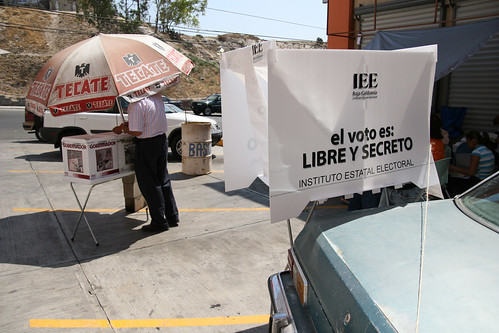 |
This time, I had my camera. I wasn’t quite sure if I was allowed to be wandering around photographing everything. As I tried to join Rosario in the makeshift voting booth to photograph the ballots, a poll worker asked me to move away. As I framed up a nearby shot, he told me I wasn’t allowed to take photographs.
I heard a woman mumbling a few feet away, “Ustedes viniendo acá, cochinando la elección. You people come here making it a dirty election.” I turned and asked what she was referring to. She seemed startled that I was challenging her passive-aggressive muttering. “Qué estoy haciendo mal con mi cámara? Quienes son ‘ustedes’? What am I doing wrong with my camera? Who are ‘you people’?” She didn’t catch the quotation marks in my inflection, and responded by saying “Soy ciudadana como tú. I’m a citizen same as you.” She walked away with her daughter before I could say any more.
As we got in the car to leave, I noticed a teenager in a group of poll workers with a video camera. My first thought was that the poll workers acted hypocritically, letting her shoot video but not letting me take photos. But when I realized she was shooting the license plate of our car, it all made sense. The woman had been referring to our California plates, showing contempt for us as “outsiders.”
 |
I slip on my untied shoes and open the door. It’s a cloudless Saturday morning in Tijuana. The clean blue sky beams the muffled sounds of a nearby loudspeaker. The community soccer court a few houses down the road is full of white tents and red-shirted organizers. It’s election time.
I walk down the cement steps to the kitchen. “Quieres almorzar? Do you want breakfast?” my mother-in-law asks. “Si, gracias” I reply. Two eggs over-easy, cebollitas (sauteed onions), beans, corn tortillas and chile. “Estuvo muy rico como siempre, It was very good as always” I tell her. She takes my plate with a small but satisfied smile.
Leaning over the bathroom sink, I lift my t-shirt collar and dry my face. It’s been a week since I shaved. I pull a clean pair of socks from my bag to replace the ones I slept in. Shoes laced and camera bag on my shoulder, I head outside.
The streets are lined with cars. The mayor is on his way. The previous mayor, Jorge Hank Rhon, made a visit the year before to inaugurate the soccer court his government helped build.
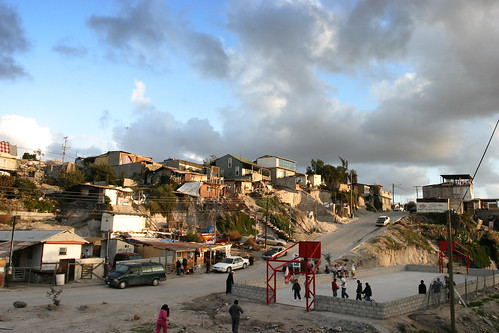 |
This morning, residents from the working-class neighborhood receive free haircuts, medical screenings, and groceries. A man plunges a syringe into the thigh of a small dog. He cries out from the sting of the free vaccine and hobbles away. A young girl scoops him up, cradling her wounded little friend. The amplified voices of the organizers raffle off food, plants and toys.
A girl approaches, maybe 20 years old, speaking to me through sunglasses. She asks who I’m with. “Vengo de la colonia para ver qué onda, I’m coming from the neighborhood, to see what’s up” I say, trying to downplay the fact that I’m clearly not from the neighborhood. She asks me who I work for, and I tell her. A public media organization in San Diego, visiting family nearby, thought I’d see what all the fuss is about. She tells me she’s a communication major. I give her one of the cards from my bag. “Estamos en contacto, We’ll be in touch,” she says walking away.
From the improvised stage, they inform the crowd that the mayor’s visit is cancelled. They explain that he had an urgent appointment with the governor and offers his sincerest apologies. But not without further adieu. They announce the distribution of the despensas, essential groceries, and diapers. The crowd exits the soccer court and forms a line at the back of a worn palette truck. Those at the back of the line urge those at the front not to mob the truck, “Respeta la fila! Respect the line!”
An hour later, the court is empty. The cars are gone. But the names of PRI party candidates Jorge Hank Rhon (running for governer of Baja California) and Jorge Aztiazarán (running for mayor of Tijuana) remain. Their signature red remains. The soccer court was strategically painted red. Hank had a large section of the border fence between San Ysidro and the beach painted red. The PRI is known for going into poor neighborhoods and giving free services. The people benefit from it. And so do the candidates.
Later that afternoon, my three nephews, my brother-in-law Fermin and I walk to the same red court for a game. They avoided the scene earlier, not wanting haircuts. “Lo cortan bien chueco, They cut it all crooked.”Fermin and I take opposite sides, and the boys split up. “Jugamos a soda, Loser buys soda.” After the game, they buy a two-liter of grapefruit Fresca and ask for 5 plastic bags. They fill the bags and pass them around. A quick twist to close the top and a tear out of the corner, it’s a refreshing victory.
After checking my stats using Google Analytics a few weeks ago, I noticed that Google included Mexico as part of Central America. I thought it odd, because I was taught Mexico was part of North America (as a Google Images search seems to confirm). After all, the NAFTA does include Mexico.
So, I wrote Google Analytics support team with the question. They responded, citing the use of United Nations data:
From: “Analytics Support” <analytics-support@google.com>
Date: June 11, 2007 4:19:59 PM PDT
Subject: Re: [#159418445] Continental ErrorHello Nathan,
Thanks for your inquiry about the maps feature in Google Analytics. We
use Standard Country and Area Codes Classifications (M49) adopted by the
United Nations Statistics Division to determine borders and continental
classifications. To see how the United Nations classifies geographic
regions, visit http://unstats.un.org/unsd/methods/m49/m49regin.htm. We
understand that borders change over time and we make every effort to
reflect the changes periodically within the product. Political borders
within the Google Analytics maps are meant to help our users understand
where their visitors are coming from and should be considered guidelines.
They in no way represent a political opinion or position . . .
The U.N.’s posted methodology also claims these regional definitions are apolitical:
The assignment of countries or areas to specific groupings is for statistical convenience and does not imply any assumption regarding political or other affiliation of countries or territories by the United Nations.
According to the Encyclopedia Britannica, some geologists and physical geographers include parts of Mexico in Central America. Wikipedia’s Central America entry quantifies this area at about 12% of Mexico’s landmass. The same entry says the European Union excludes Mexico and Belize from Central America.
The issue brings home the basic premise that borders and labels can be completely arbitrary. That is, if we removed the labels and borders, we would have land and people living on that land. The borders we have in our world today are 100% political. They establish boundaries where each country considers itself sovereign. When borders move, it’s often a matter of life and death for the locals.
Is it wrong for the U.N. to label Mexico as part of Central America? I don’t know and it doesn’t affect my daily life one way or the other. It does, however, affect the way people and cultures respond to each other. In the U.S., if Mexico is part of “our” North American continent, we might have reason to consider ourselves neighbors. When the U.S. Americans refers to Mexico as “Latin America” it’s an added step of distance, a clarification that those people are something “other” than us. Whether we like it or not, the U.S.A. is the minority in the Americas, and the largest minority group within the country is made up of Latinos. The U.S. is part of Latin America.
I can understand a geological explaination that deals with physical land formations. But in any other circumstance, you usually round down. Twelve percent would still exclude Mexico from Central America. It seems like an easy excuse to distance a “third world” country like Mexico from “first world” countries like the U.S. The disclaimer that their maps don’t express a political opinion seems more like a cop-out, not unlike television news programs’ use of the question mark.
